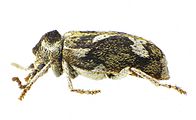Light-colored rodent beetle
| Light-colored rodent beetle | ||||||||||||
|---|---|---|---|---|---|---|---|---|---|---|---|---|

Light-colored rodent beetle ( Ptinomorphus imperialis ) |
||||||||||||
| Systematics | ||||||||||||
|
||||||||||||
| Scientific name | ||||||||||||
| Ptinomorphus imperialis | ||||||||||||
| ( Linnaeus , 1767) |
The light-colored rodent beetle ( Ptinomorphus imperialis ) - also known as the Imperial Poch beetle - is a beetle from the family of rodent beetles (Ptinidae).

|
|
| Image 1: top view | Photo 2: bottom |

|

|
| Image 3: side view | Image 4: front |
features
The light-colored rodent beetle reaches a size of around four millimeters. On the pronotum and the wing covers there is a conspicuous drawing made up of whitish brown hairs. The punctuation below is covered by this. The wing covers have no longitudinal ribs. The pronotum has a high keel and is provided with a sharp edge that, when viewed from the side, forms approximately a right angle. There are individual, protruding black bristles between the basic scales. The bright drawing of the elytra also includes the tips of the elytra.
Similar species
- Ptinomorphus regalis (Duftschmid, 1825), the pronotum keel forms an obtuse angle when viewed from the side. The wing covers have longitudinal ribs. The light drawing does not extend to the tips of the elytra
Synonyms
- Bruchus cruciatus Geoffroy in Fourcroy, 1785
- Bruchus imperialis OF Müller, 1776
- Hedobia alpina Pic, 1898
- Hedobia angustior Pic, 1896
- Hedobia interrupta Pic, 1893
- Hedobia maculata Pic, 1922
- Ptinomorphus dayremi Pic, 1942
- Ptinomorphus luteosuturalis Pic, 1925
- Ptinomorphus nigronotatus Pic, 1942
- Ptinomorphus senex Kraatz, 1876
- Ptinomorphus theresae Pic, 1933
- Ptinomorphus x-notatus Pic, 1942
Way of life
The larvae of the light-colored rodent beetle develop between the bark and the wood of fungus, damp dead wood of various hardwoods such as hornbeam ( Carpinus betulus ), hazel ( Corylus ), elm ( Ulmus ) and linden ( Tilia ). In contrast to wood worms, dry construction or furniture wood is not attacked by this species . The adult beetles feed on pollen and nectar from flowering shrubs such as blackthorn ( Prunus spinosa ) or hawthorn ( Crataegus ).
distribution
The light-colored rodent beetle is common in Europe in the north to Denmark and the south of Norway and Finland. In England and Ireland he can only be found locally.
credentials
Heinz joy , Karl Wilhelm Harde , Gustav Adolf Lohse (ed.): The beetles of Central Europe . tape 8 . Teredilia Heteromera Lamellicornia . Elsevier, Spektrum, Akademischer Verlag, Munich 1969, ISBN 3-8274-0682-X , p. 30 .
- ↑ a b c d e f g h i j k l Ptinomorphus imperialis (Linnaeus 1767). Fauna Europaea, Version 1.3, April 19, 2007, accessed June 18, 2007 .
- ↑ Jiři Zahradnik, Irmgard Jung, Dieter Jung et al .: Beetles of Central and Northwestern Europe. Parey, Berlin 1985, ISBN 3-490-27118-1 .
